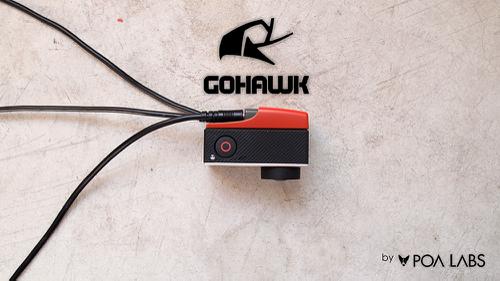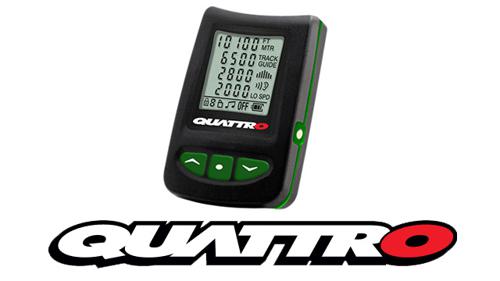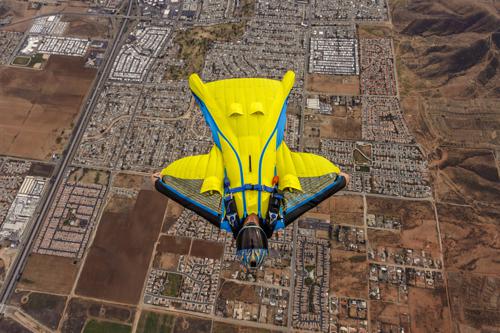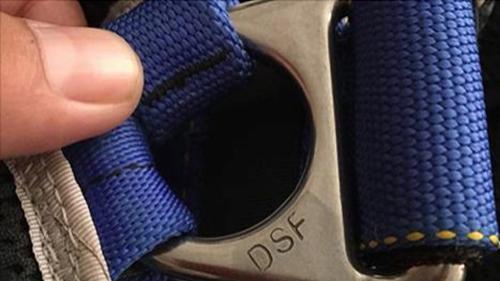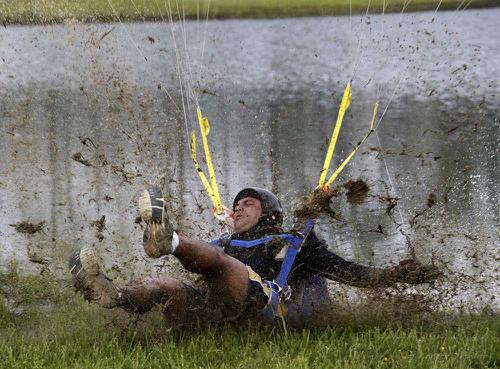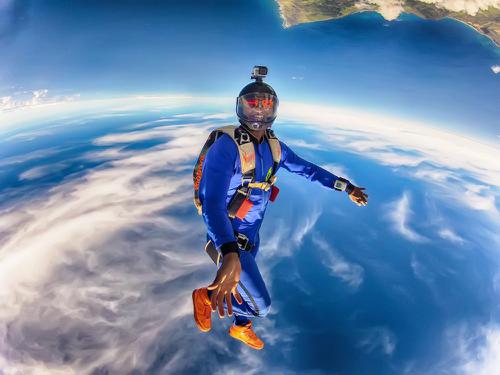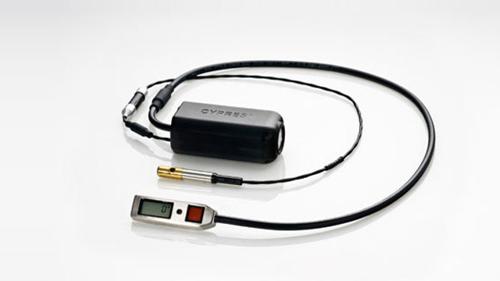The first tracking suit was a humble thing indeed.
Invented by pioneers of the tracking discipline in the unforgiving terrain atop Norway’s bigwall exits, the first suits were resourceful repurposings of the stuff they already had on-hand – the rain gear required by Norway’s reliably inclement weather, and the cigarettes they used to while away the time as they waited for it to pass.
The “big idea” was simple: increase a tracker’s surface area, and he/she can use it to fly longer, flatter, faster and farther from the danger posed by the solid object behind him. With this in mind, someone -- no one quite remembers who -- burned cigarette holes in their waterproofs, positing that enough air would enter the holes to afford meaningful inflation. Somewhat miraculously, it worked. The rest, as they say, is history.
The first purpose-built version, the original Phoenix Fly tracking suit, was introduced in 2004. Until recently, it has seen little serious competition: suit tracking was born by and for the BASE environment, and non-BASE-jumpers had little interest in it outside of its contested, folk-wisdomy usefulness as a stepping stone to wingsuiting.
The past year has changed everything. Skydiving and BASE have both seen an unprecedented boom in participating athletes -- as well as a notable rise in tracking as a specialization. Whether the boom owes to a sharp increase in wingsuit-related incidents or to a renewed interest in tracking subdisciplines such as angle flying is unclear, but the empirical evidence speaks for itself. In any case, suit manufacturers have responded with an explosion of new technologies and designs. The new range aims for lighting-fast inflation, foolproof pressurization, optimized lift-drag ratios and multi-orientational usability. In a couple of cases, the designs even introduce wingsuitesque one-piece construction into the mix.
I five brand-new suits through their paces in both the BASE and skydiving environments to find out which provide an optimum performance in different circumstances. Here’s the rundown on my findings.*
*You will note that I am one human, and that, while I have quite a lot of time in tracking suits, I am not any kind of god, savant or superwoman. Your experience may vary from mine. Heck, it’s likely to.
By Joel Strickland
The Suits
Phoenix-Fly Power Tracking Suit
Currently the most popular tracking suit on the market, Phoenix Fly’s Power Tracking Suit is the more powerful baby brother of Phoenix Fly’s venerable and much-beloved Original Tracking Suit. Along with a bigger general profile, the new suit integrates thicker stiffening fabric, additional gear pockets on the jacket, tougher construction, mesh lining and inlets redesigned to deliver quicker pressurization. Aerialists love its forgiving transitions, and the power zone is relatively easy for lower-experience trackers to find (though Phoenix-Fly suggests a minimum of 120 jumps on the Original Tracking Suit before putting on the Power).
I found the Power Tracking Suit to be instantly comfortable, and its construction to be thoughtful and solid. While the suit doesn’t have the raw power of some of the other new offerings, it’s accessible, predictable and confidence-inspiring – which is probably why so many personal-best tracks have been performed in it.
Pressurized Tube 4
The Tube 4’s predecessor, the Tube 3, was a polarizing piece of gear. Trackers either loved or hated it, citing distinct roll-and-yaw wiggliness and unpredictability during the transition. In response, Pressurized redesigned the Tube 4 from the ground up. Features include inflation-staging leg inlets, zipper safeties and a thicker arm profile. Long, strong stiffeners at the front of the calf effectively smooth the leg profile. Backfly inlets are available (though not standard), and zippers aside the leg open up a sizeable extension to the leg volume.
Given my previous experience with the Tube 3, I was expecting a rodeo when I tested the new suit in the BASE environment. I was shocked by the new suit’s ease of use: it was a baby-smooth ride from the get-go. Though it took a bit of trial-and-error to find the power zone, the Tube 4’s transition was among the smoothest I’d ever experienced.
I had a couple of nagging issues with the Tube 4’s construction. For one, I found the vent-stiffening material easily malforms – and quickly “learns” the new shape – when the suit is folded for packing. (Overnight storage on a wide-shouldered hanger reduces the problem, but doesn’t solve it; after all, the suit has to go into a stash bag sometime.) Beyond that, I was constantly fighting my suit’s sticky zippers.
Tony Suits Masai
There’s no denying that the Tony Masai, wingsuit manufacturer TonySuits’ first tracking offering, is a head-turner. I was the subject of several baffled stares as I marched across Skydive Empuriabrava in it – probably, because the one-piece Masai looks neither like a tracking suit nor a wingsuit but an idiosyncratic combination of both. Where other tracking suits are distinctly baggy, aiming to inflate across the entire body, the central body of the Masai is unusually trim. This decidedly anomalous design inflates via both front and back inlets on a set of tubular fabric “rails” that run from armpit to ankle and down the inseams. The jumper’s rig zips in just like a wingsuit. The Masai comes standard with Cordura booties, stealth-rubber soles, backfly inlets and a humorously roomy zippered pocket positioned right on the seat.
When I first geared up in the Masai, I was worried about inflation. In other, far looser suits, a slight bend in the limbs doesn’t noticeably deform the inflating portion of the suit; on the Masai, however, slight changes in the articulation of legs and arms pulled the fabric unnervingly taut to the body. When I jumped it, however, my worries were instantly dispelled. While the Masai tended to misbehave in a steep dive, the suit kept its inflation admirably through the rest of the test maneuvers, achieved solid marks for distance and delivered the crispest transition to and from backfly of any tested suit.
S-Fly Cruise
Fly Your Body’s first addition to the field, the Cruise, is getting a lot of attention, and not just because it’s the suit that Fred Fugen and Vince Reffet used for their record-breaking freefly-tracking jump from the Burj Dubai. The Cruise is massive, it’s intelligently designed, and it’s delivering eyebrow-raising results from trackers with low jump numbers.
The suit features several industry-first advancements. Internal airlocks maintain pressurization. Thumbloops on both sides (so they remain available whether you track with palms up or down) keep the arm stable. An integrated deflector improves airflow around the jumper’s rig. The Cruise comes standard with both front and back inlets and removable booties (as well as the option to order rubber with a BASE tread).
The wide, one-piece design inflates centrally -- very differently from a two-piece design, which is necessary cinched around the waist. (Jumpers can expect this to result in yaw instability during the first few jumps.) The Cruise’s optimal flying technique moves closer to that of a wingsuit than a born-and-bred tracking suit, and it’s a lot for a newer jumper to handle. However, an athlete with some experience -- and the time and willingness to put a few skydives on the suit -- will likely have the same take-away I did: something akin to jaw-on-the-floor disbelief.
Squirrel Sumo
The Squirrel Sumo is aptly named: it’s a very burly suit. It’s so voluminous, in fact, that it’s likely to be mistaken for a small wingsuit in a stash bag. The Sumo comes standard with a bevy of thoughtful details: loads of oversized, difficult-to-deform Mylar inlets, a close-fitting collar and cuffs to prevent air escape, three Mylar-reinforced toe tension settings, Cordura reinforcements and brawny industrial-grade zippers. Uniquely, Squirrel’s suit also includes Velcro-fastened stabilizers on the inner leg to prevent its abundance of fabric from jostling out of position on exit.
All that fabric, flown correctly, delivers rocketship power. My first skydives on the Sumo were gainers from the back of a military Casa over the open ocean off the coast of Panama, and the suit ferried me back to the island landing area with room to spare. I was pleased to see that it was racking up similar distances to smaller flocking wingsuits without much dialing-in.
In full flight, the Sumo felt rock-solid. As with any other large suit – especially one that inflates as quickly and sizeably as the Sumo – BASE exits proved a trickier proposition, though the field-leading start speed is well worth the effort to workshop. Note: Squirrel purpose-built the Sumo to maintain solid internal pressure in order to outfly aggressive exits in the BASE environment. Because of that laser focus, you won’t find backfly inlets on the Squirrel.
[Originally published in Skydive Dubai’s now-defunct Dropzone Magazine, Fall 2014]

